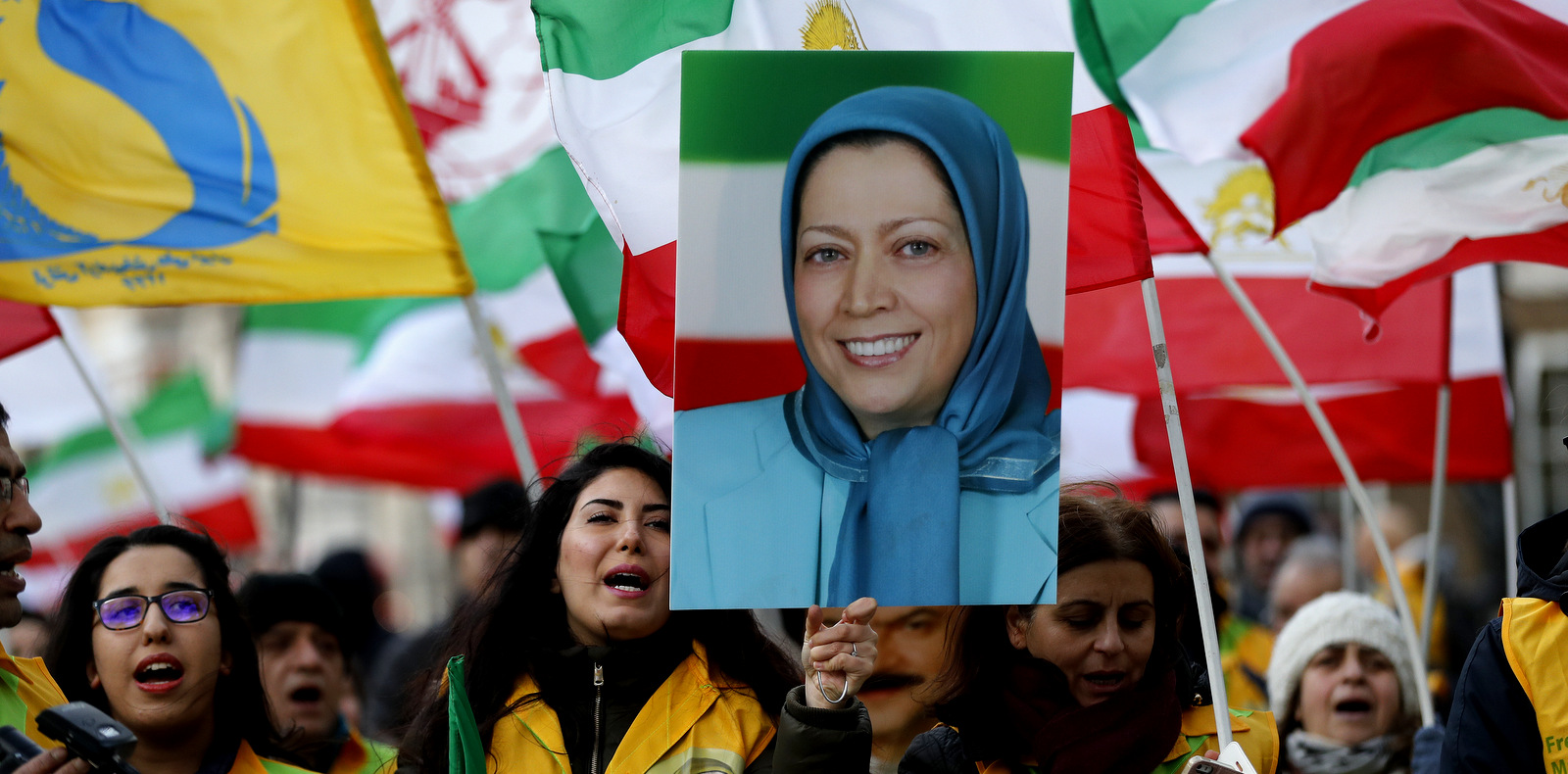Washington’s pulling out of the Iran nuclear deal and subsequently renewed sanctions come as US National Security Advisor appointee John Bolton’s existential objective to destroy Iran by any means necessary even if it means leveraging the soft power of a cultish death squad.
US President Donald Trump ramped up the threat with a Game of Thrones meme warning Iran, with a November 5 deadline, that “Sanctions are Coming.” Qasem Soleimani, a Major General in Iran’s Revolutionary Guard, responded with a meme of his own that Friday with the message “I will stand against you.”
More than just rhetoric, the exchange signified the high pomp the mention of sanctions posted to the Islamic Republic following an extensive international campaign by the US and Iranian expat and separatist allies to maximize their impacts.
The United States has slapped around a dozen sanctions on Iran since 1984 including two rounds on its shipping, oil, banking, and ship-building sectors since Trump’s removal from JCPOA earlier this year. These include five UN security council resolutions between July 2006 and 2008.
Despite the language of nuclear non-proliferation, one aim of the sanctions is to facilitate an atmosphere of intense economic frustration in hopes of inciting regime change — or what the State Department insists is just a change in “regime behavior.” This strategy includes supporting separatist groups like the MEK to accomplish this goal — without pulling the United States into another armed conflict.
The MEK originally began as a leftist student group, joining a coalition of forces against the Shah at the onset of the 1979 revolution. Relations with Iranian revolutionary leader Ruhollah Khomeini quickly soured after the Islamic Republic took power. The group carried out sophisticated bombings against the state, including a 1981 bombing that killed 74 government officials and another two months later that detonated in the Prime Minister’s office, killing President Mohammad Ali Rajaei, Prime Minister Mohammad Javad Bahonar, and three others. Before the revolution, the MEK was responsible for attacks against American civilians and was later housed, supported, and trained by Saddam Hussein during the Iraqi-led, US-backed 1980-1988 war. A history of waging terror attacks inside Iran and abroad in support of destabilizing the current government has rendered them natural allies with the US.
It was also in exile that the organization rebranded from an “Islamo-Marxist” to a pro-free market, Western-allied one to win the support of Europe, the West, and other reactionary powers in the Middle East. A history of waging terror attacks inside Iran and abroad in support of destabilizing the current government have rendered them natural allies with the US.
In addition, various NATO powers have hosted and given the separatist groups coverage in attempts of strengthening support and ties with the United States. They Include France, where the MEK and its umbrella organization NCRI is based, Denmark and the Netherlands, housing Arab Struggle Movement for the Liberation of Ahvaz (ASMLA), and Albania, where a MEK camp, housing a training ground and even Twitter troll-farm, pumping out anti-government tweets and pro-Rajavi propaganda, is based.
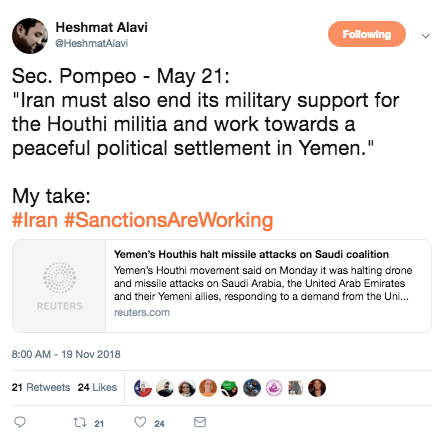

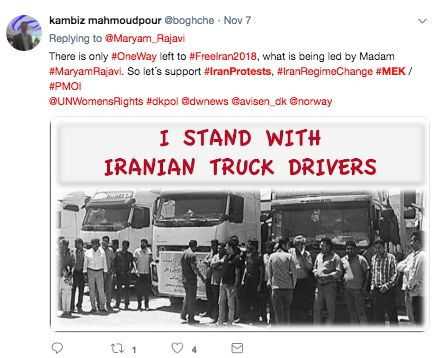
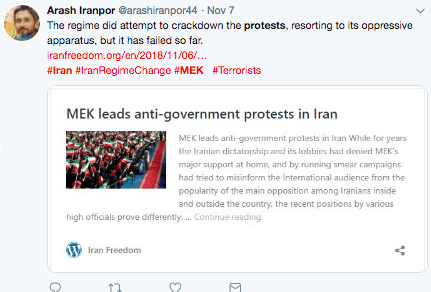
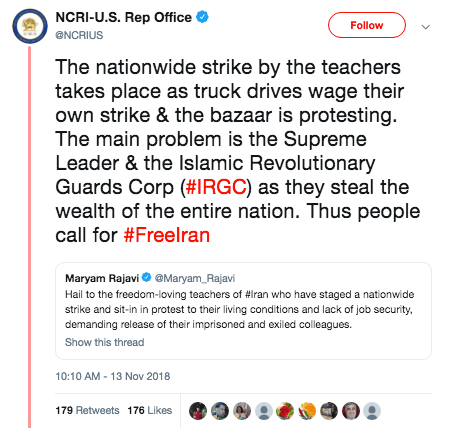
Anti-government and “Persian” or “Aryan” nationalist Twitter accounts, exclusively Tweeting anti-regime information, hashtag #IranStrike #FreeIran, and #IranRegimeChange, and circulate pro-Rajavi propaganda photos. Many openly express their support of their right-wing, US spokesperson, retweeting former US ambassador and MEK lobbyist John Bolton.
News of sporadic labor strikes, such as those in the steel industry in Ahvaz, conveniently coincided with each round of sanctions: both in early November and in August. As Iran’s industries, including steel, sugar cane, and automotive, become amongst many taking significant hits following US sanctions, coverage of the protests, with sources almost exclusively by pro-NCRI and pro-Gulf media outlets, frame this as evidence of government corruption and mismanagement rather than an effect of sanctions co-opted for regime change narrative purposes.
While the US doesn’t have all that much faith in the MEK as a credible and reliable proxy alternative, the group seems to be their best bet in helping open up Iran’s free markets, allying with NATO powers, and neutralizing Iran’s support for resistance movements in Gaza, Lebanon, and Yemen against US-backed allies Israel and Saudi Arabia.
In October, terrorist attacks in Paris and Denmark led the NCRI/MEK’s propaganda outlets to point to the Islamic Republic to blame. Secretary Mike Pompeo, addressing an audience of Iranian-American expats at the Ronald Reagan Presidential Foundation and Library in July in support of escalating tensions with Iran and solidifying support amongst Iranian separatists with the US and Israel, issued a Tweet immediately after the attack attempt framing the Iranian government and calling for “allies and partners” to “confront” Iran.
We congratulate the government of #Denmark on its arrest of an Iranian regime assassin. For nearly 40 years, Europe has been the target of #Iran-sponsored terrorist attacks. We call on our allies and partners to confront the full range of Iran’s threats to peace and security.
— Secretary Pompeo (@SecPompeo) October 30, 2018
The attacks came at a time where the Iranian government was attempting to curtail the effect of US sanctions by strengthening economic ties with the European Union. In response to the pressure, France placed a freeze on Iranian intelligence assets in October. Despite the lack of evidence pointing to the Islamic Republic as the perpetrators of the Europe attacks, those European Union nations are considering following suit in a shift in policy towards sanctions.
The attacks were pushed by MEK and al-Ahwaz, the latter of which waged a deadly terrorist attack against a southwest Iran military parade that killed 25 civilians a month prior. Denmark, the Netherlands, and France’s coverage to groups like the MEK in Paris and Arab Struggle Movement for the Liberation of Ahvaz (ASMLA) in Denmark, accomplished its objectives of garnering support for EU sanctions against Iran. The Zionist intelligence body Mossad assisted in the effort, tipping Danish intelligence off to blaming Iran.
The MEK’s lack of any real support in their country of exile has prompted it to refocus its efforts on it’s “international audience,” winning the sympathies of the West and the US. After 2006, the Bush administration ramped up financial support for Iranian expat civil society organizations, through its newly instated ‘Iran Democracy Fund’. That year, an additional $75 million went to promoting a change in “regime behavior.”
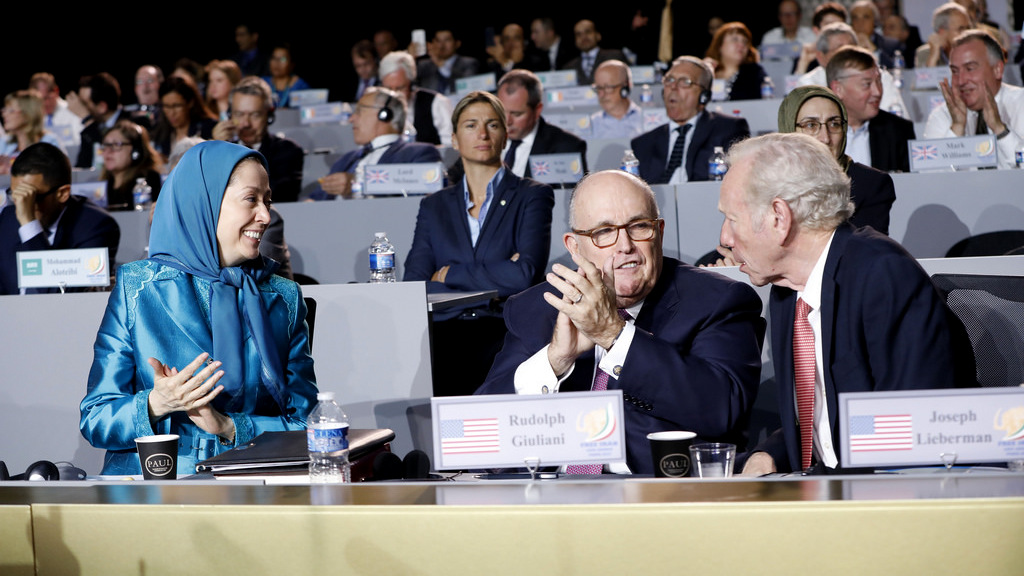
Left to right: Maryam Rajavi, former MEK leader and leader of the National Council of Resistance of Iran talks with Rudy Giuliani and Senator Joe Lieberman at s free Iran Gathering, July 1, 2017. Flickr | Maryam Rajavi
Outside funds have supported a number of expat radio stations and media outlets, including London-based and Saudi-backed Iranian International, hosting Denmark-based ASMLA spokesperson to report that the attacks on the Ahvaz military parade terrorist attack in Iran were against military targets, France-based Iranian News Update, and Iranian News Wire in California. Of these include Radio Farda, established in 2002 as the Iranian branch of US-funded Radio Free Europe, having met with the Israeli Defense Minister in September and interviewed Shimon Peres in 2014. With the support of Israel and the United States, the station’s objectives of advancing the goal of the conglomerate in advancing the goals of US and NATO foreign policy, regularly providing positive press and favorable coverage for the US (having used sources directly from the CIA) and Israel, using falsified information. Though the station is banned in Iran, enjoying the support of anti-government expats, Israel claims it is the most widely listened to source in Iran, signaling a media relationship just as prolific as its political and intelligence based ones.
In January, MintPress News found that the United States spent over $1 million dollars since 2016 towards pro-regime change funding. Many of these funds also came from Saudi Arabia whom the MEK has always kept the relationship secret. These funds help bankroll media, lobby American elected officials, buy up land in Albania to use for training and propaganda camps and to support a headquarters in France. They even included John Bolton’s personal $180,000 stipend.
The proliferation of the unrest in the 2017-2018 protests received immediate support from US far-right, such as Trump, Paul Ryan, and John Bolton. Many top figures from the US far-right right-wing political pundits, who have aggressively fought civil liberties and support for workers rights in the US, were the first to issue their lip service support of the demonstrations. Just a month before the 2017 protests, CIA analyst Kenneth Katzmann concluded that “domestic factors” that would incite “an uprising” would, towards the potential favor of US war hawks, “precipitate policy changes that either favor or are adverse to US interests.”
In late September, the Trump administration outlined in a report entitled “Outlaw Regime: A Chronicle of Iran’s Destructive Activities” identified as the government’s top “destructive activities,” highlighting its support of what the Trump administration considers “support of terrorist militias and proxies.”
The report devoted two sections to Iran’s “human rights” and “environmental” abuses, with the proposed solutions to not only continue US funding to these groups — many of whom echo accusations the US waged in its justification of anti-Iran hostilities.
Congress had previously allocated over $20 million for “democracy promotion” in Iran, following accusations that Iran possessed nuclear weapons. It was the MEK that had given false and misleading information to US intelligence on Iran’s alleged possession of nuclear weapons in 2002, a year before the US destabilized Iraq over accusations of “weapons of mass destruction.” This polemic, inspiring an odd part of then-president George W Bush’s “Axis of Evil” speech, is also solidified in MEK leader Maryam Rajavi 10-point plan. The last point demands a “non-nuclear Iran,” calls for the Islamic Republic be “free of weapons of mass destruction.”
Despite its early leftist leanings, the group today galvanizers “private property” and “the free market” as another core component of its 10 point manifesto. The aggressively neoliberal rhetoric of the MEK, winning over the sentiments of Western so-called human rights values and ideals in many of these Western-backed and Saudi-sponsored “human rights” NGOs, provides the material and strategic support for economic and foreign policies that are the motivator for the regime-change inclinations against Iran. But they also solidify their support amongst many wealthy Iranian expats, angered by the government’s policies of aggressive wealth and asset redistribution and level of economic centralization comparable to socialist Cuba.
The 30 other countries that are on the US’s regime change shit list also work through similar propaganda tactics. Top foundations employ the same tactics of objectives of regime change through “diplomatic” networks, such as the National Endowment for Democracy (NED), set up in 1980. As of now, the activities of the NED include photo ops in Washington DC to support Nicaragua regime change and financing.
The NED continues its policy and these activities in Iran through the “Foundation for Democracy,” whose board and work consists of a cohort of fellows and officials with right-wing think tanks, various U.S. intelligence agencies, defense companies, and contractors, and, like co-chair William Norjay, have accrued experience in other regime change propaganda apparatuses against countries like Cambodia, Afghanistan, and Ukraine.
Shortly after the U.S. announces the abandonment of its regime change policies in Syria, it is shifting its energy more towards direct confrontation with Iran. In the aftermath of failed proxy wars, the rehashing of old soft-power strategies might just be the “lessons for Washington” on how to overthrow a regime Bolton has contemplated in a 2013 op-ed in what he considered an otherwise “accomplished” ouster of Saddam Hussein in 2003.
Top Photo | Supporters of Iran’s National Council of Resistance of Iran (NCRI) hold a rally opposite the entrance of 10 Downing Street in London, Jan. 4, 2018, the woman pictured is former MEK leader Maryam Rajavi. Frank Augstein | AP
Source | Geopolitics Alert
The post How the US Uses the “Leftist” MEK for Soft Aggression Against Iran appeared first on MintPress News.
